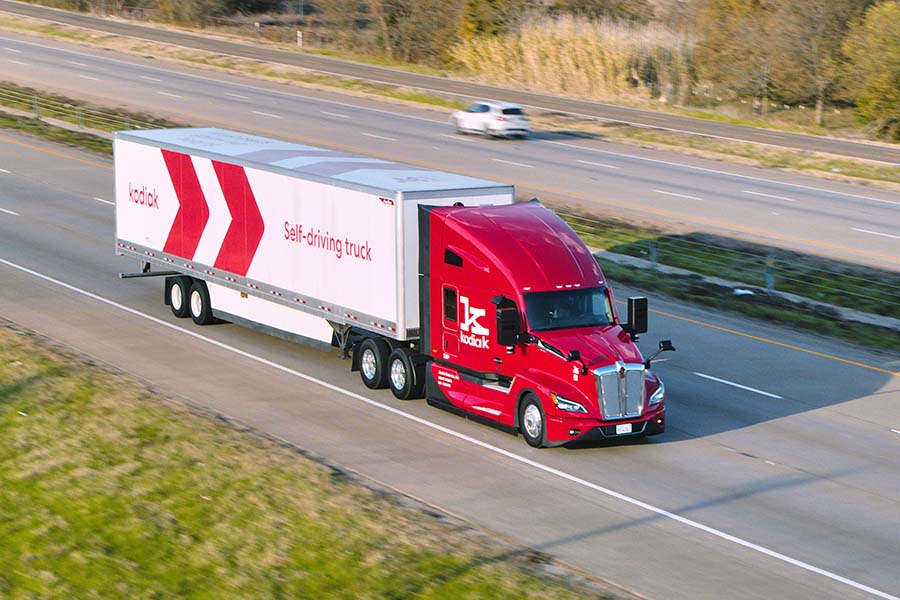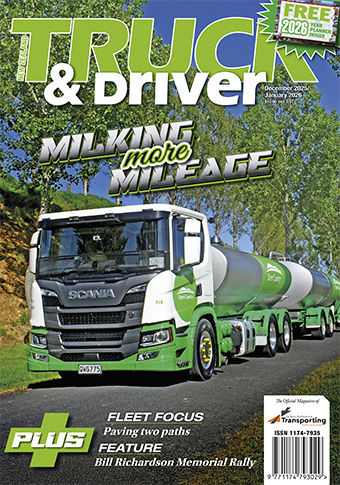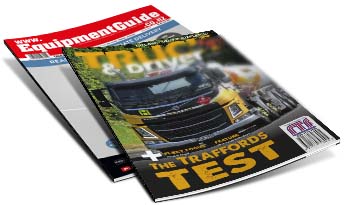Aeolus Truck & Driver News


Fifth generation self-driving technology
Aeolus Truck & Driver News
The evolution of self-driving truck technology has seen Kodiak Robotics introduce the fifth-generation of its Kodiak Driver autonomous truck hardware platform.
The gen-5 technology increases sensor redundancy and GPU processing power and notably, Kodiak has removed the roof-mounted “centre pod” sensor suite. The front-facing Luminar Iris LiDAR and wide field-of-view camera have been relocated to each of Kodiak’s proprietary mirror-mounted SensorPods.
By integrating sensors into the SensorPods and eschewing the “unibrow” sensor suite common in the autonomous trucking industry, Kodiak has unlocked faster upfitting for customers, greater maintainability and better perception capability. The move also doubles the LiDAR coverage at long range.
Relocating the sensors to the SensorPods on the side-mounted mirrors, Kodiak has also simplified the build process. And by having sensors located in an easy-to-reach location on the mirrors, customers avoid having to access the roof to maintain sensors.
...The evolution of self-driving truck technology has seen Kodiak Robotics introduce the fifth-generation of its Kodiak Driver autonomous truck hardware platform.
The gen-5 technology increases sensor redundancy and GPU processing power and notably, Kodiak has removed the roof-mounted “centre pod” sensor suite. The front-facing Luminar Iris LiDAR and wide field-of-view camera have been relocated to each of Kodiak’s proprietary mirror-mounted SensorPods.
By integrating sensors into the SensorPods and eschewing the “unibrow” sensor suite common in the autonomous trucking industry, Kodiak has unlocked faster upfitting for customers, greater maintainability and better perception capability. The move also doubles the LiDAR coverage at long range.
Relocating the sensors to the SensorPods on the side-mounted mirrors, Kodiak has also simplified the build process. And by having sensors located in an easy-to-reach location on the mirrors, customers avoid having to access the roof to maintain sensors.
Kodiak’s SensorPods are also designed to place sensors at the same height as a driver, maximising road safety and improving perception. The SensorPods offer a better dual vantage point, as they provide redundancy and visibility on either side of the truck, as opposed to the single vantage point above the cab.
In the event of a sensor damage, such as a rock or other piece of debris damaging a sensor, the dual-redundant front-facing sensors increase resiliency. Replacement of SensorPods, which are compatible with any truck platform, can be performed in as little as 10 minutes.
The fifth-generation Kodiak truck adds a second forward-facing LiDAR and additional camera to add redundancy in the left and right SensorPods.
The new system increases the total number of sensors on-board from 14 to 18, including one new LiDAR and three new cameras — bringing the total camera count to 10. Two wide-angle cameras were added to the hood-mounted mirrors to cover blind spots.
Kodiak’s long-range sensor suite is split evenly between the two side-mounted mirror SensorPods. There are four ZF Full Range Radar for redundancy; two Hesai 360-degree scanning LiDARs for side- and rear-view detection; two Luminar Iris LiDAR sensors, and 8 cameras, which include both wide and narrow field-of-views.
The new truck includes the new Ambarella CV2 perception system-on-chip (SoC) which handles all camera data processing and improves image quality for longer range detections and unlocks improved dynamic range for night time driving.
“Customers and OEMs aren’t sensor experts, and they shouldn’t have to be, which is why they constantly tell us they love our modular approach that solves one of the biggest barriers to servicing and maintaining autonomous trucks,” says Don Burnette, Founder and CEO of Kodiak Robotics.
“By removing the sensors from the top of the truck and incorporating them at a human driver’s line of sight, we have designed a system for the real world. Additionally, having sensors on top of the cab is actually very difficult to service while on the road and requires specialised equipment, which is nearly impossible to find roadside.”
Kodiak also reduced the electrical power requirements for its fifth-generation truck, while simultaneously improving the processing power of the system. In addition to 130% more GPU processing power, the new system provides 60% more central processing power, and additional system redundancy. The reduced power consumption allowed for a 50% reduction in the size of the fifth-generation power system, and also decreased cooling needs.
Like Kodiak’s fourth-generation truck, Kodiak’s fifth-generation truck includes Cummins X15 engines, and Bridgestone smart-sensing tyre technology. The introduction of this new generation platform comes during a period of substantial growth for Kodiak, including a 24-month US Department of Defense project to help automate future U.S. Army ground vehicles.



 + EQUIPMENT GUIDE - FREE
+ EQUIPMENT GUIDE - FREE
